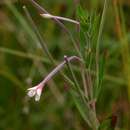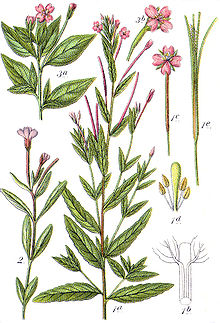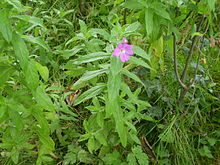Epilobium is a genus of flowering plants in the family Onagraceae, containing about 197 species.[1] The genus has a worldwide distribution. It is most prevalent in the subarctic, temperate and subantarctic regions, whereas in the subtropics and tropics Epilobium species are restricted to the cool montane biomes, such as the New Guinea Highlands.
The taxonomy of the genus has varied between different botanists, but the modern trend is to include the previously recognised genera Boisduvalia, Pyrogennema and Zauschneria within Epilobium. Chamaenerion, (previously Chamerion), is considered distinct, however,[2] according to Peter H. Raven, who has extensively studied the willowherbs and merges the other segregate genera into Epilobium. Fringed willowherb (Epilobium ciliatum) is likely a cryptic species complex; apparently these plants also commonly hybridize with their congeners.[3]
Most species are known by the common name willowherbs for their willow-like leaves.[4] Those that were once separated in Boisduvalia are called spike-primroses or boisduvalias. Those Epilobium species previously placed in the Chamaenerion group and known as fireweeds are now segregated into the genus Chamaenerion.
Description
Epilobiums are mostly herbaceous plants, either annual or perennial; a few are subshrubs. The leaves are opposite or rarely whorled,[5]: 354 simple and ovate to lanceolate in shape. The flowers are actinomorphic (radially symmetrical) with four petals that may be notched.[5][6] These are usually smallish and pink in most species, but red, orange or yellow in a few. The fruit is a slender cylindrical capsule containing numerous seeds embedded in fine, soft silky fluff which disperses the seeds very effectively in the wind.
The genus name derives from the Greek words "epi" meaning "upon" and "lobos" meaning "lobe", with reference to position of the petals above the ovary.[7]
A number of Epilobium species with slightly asymmetrical (zygomorphic) magenta flowers and alternate leaves were placed in a Chamaenerion group, and have been separated by some authorities into the genus Chamerion. However, Chamerion has not been universally accepted[8] and there is now emerging consensus that this group of species should be segregated into the genus Chamaenerion.[9][10]
Habitat and ecology
Willowherbs sensu lato are typically very quick to carpet large swathes of ground and may become key or dominant species of local ecosystems. In the United Kingdom, for example, rosebay willowherb (Chamaenerion angustifolium) is widely found on mesotrophic soils dominated by false oat-grass (Arrhenatherum elatius), cock's-foot grass (Dactylis glomerata), and red fescue (Festuca rubra), while great willowherb (Epilobium hirsutum) is found in mesotrophic grassland with stinging nettle (Urtica dioica). These two willowherb species also dominate open habitat early in ecological succession, to the virtual exclusion of other plant life. Broad-leaved willowherb (Epilobium montanum) is found characteristically, though not abundantly, in the mesotrophic grasslands with meadowsweet (Filipendula ulmaria) and sometimes the uncommon Greek valerian (Polemonium caeruleum). Most willowherbs will not tolerate shade trees and thus are limited to more recently disturbed patches, yielding to other plants over time. Consequently, though the genus contains many pioneer plants, rather few of them are invasive weeds of major importance.
Epilobium species are used as food plants by the caterpillars of certain Lepidoptera species, including:
Geometridae
-
Grey pug (Eupithecia subfuscata), recorded on several species
Noctuidae
Sphingidae
Use by humans
The main use of Epilobium by humans is as a herbal supplement in the treatment of prostate, bladder (incontinence) and hormone disorders. Many of the small willowherb species are nuisance weeds in gardens. Though few are regularly used as ornamental plants, the larger willowherbs may be attractive in ruderal locales. One of the most frequently recognized members of the genus is the circumboreal fireweed (E. angustifolium), known as rosebay willowherb in the United Kingdom. It rapidly colonizes burnt ground; during the bombing of London in World War II many of the derelict bomb sites were soon covered with these plants, bringing a splash of colour to what was otherwise a very grim scene. It is the floral emblem of Yukon in Canada, Hedmark in Norway (where it is called geitrams) and Southern Ostrobothnia in Finland.
Fireweed is used as a sweetener in northwestern North America. It is put in candy, jellies, ice cream, syrup, and sxusem ("Indian ice cream"). In the late summer its flowers yield pollen and copious nectar which give a rich spicy honey. Its young leaves, roots, and shoots are edible (if somewhat bitter), and rich in provitamin A and vitamin C. The Dena’ina found them also useful as food supplement for dogs and applied sap from the stem to wounds, believing it to have antiinflammatory properties.
Several researchers have studied this taxon. Heinrich Carl Haussknecht in the late 19th century and Peter H. Raven about a century later researched the phylogeny, systematics, and taxonomy of willowherbs. Peter Michaelis' studies of this genus paved the way for understanding of extranuclear inheritance in plants.
Species
The National Museum of Natural History recognizes an intermediate number of about 197 species in 10 sections, and consider the former section Chamaenerion (=Chamerion), as a distinct genus.[2] Other sources may list one or two dozen species, more or less:
Section Boisduvalia
Section Cordylophorum
- Subsection Nuttalia
- Subsection Petrolobium
Section Crossostigma
Section Epilobiopsis
Section Macrocarpa
Section Xerolobium
Section Zauschneria
Section Epilobium
-
Epilobium aitchisonii P.H.Raven
-
Epilobium algidum M.Bieb.
- Epilobium alpinum
-
Epilobium alpestre (Jacq.) Krock.
-
Epilobium alsinifolium Vill. – chickweed willowherb
-
Epilobium alsinoides A.Cunn.
-
Epilobium alsinoides ssp. alsinoides
-
Epilobium alsinoides ssp. atriplicifolium (A.Cunn.) P.H.Raven & Engelhorn
-
Epilobium alsinoides ssp. tenuipes (Hook.f.) P.H. Raven & Engelhorn
-
Epilobium amurense Hausskn.
-
Epilobium amurense ssp. amurense
-
Epilobium amurense ssp. cephalostigma (Hausskn.) C.J.Chen, Hoch & P.H.Raven
-
Epilobium anagallidifolium – alpine willowherb, pimpernel willowherb
-
Epilobium anatolicum Hausskn.
-
Epilobium anatolicum ssp. anatolicum
-
Epilobium anatolicum ssp. prionophyllum (Hausskn.) P.H.Raven
-
Epilobium angustum (Cheeseman) P.H. Raven & Engelhorn
-
Epilobium arcticum Sam. – Arctic willowherb
-
Epilobium astonii (Allan) P.H.Raven & Engelhorn
-
Epilobium atlanticum Litard. & Maire
-
Epilobium australe Poeppig & Hausskn.
-
Epilobium barbeyanum H.Lév.
-
Epilobium billardierianum Ser. – glabrous willowherb
-
Epilobium billardierianum ssp. billardierianum
-
Epilobium billardierianum ssp. cinereum (A.Rich.) P.H.Raven & Engelhorn
-
Epilobium billardierianum ssp. hydrophilum P.H. Raven & Engelhorn
-
Epilobium billardierianum ssp. intermedium P.H. Raven & Engelhorn
-
Epilobium blinii H.Lév.
-
Epilobium brevifolium D.Don
-
Epilobium brevifolium ssp. brevifolium
-
Epilobium brevifolium ssp. trichoneurum (Hausskn.) P.H.Raven
-
Epilobium brevipes Hook.f.
-
Epilobium brevisquamatum P.H.Raven
-
Epilobium brunnescens (Cockayne) P.H. Raven & Engelhorn – New Zealand willowherb
-
Epilobium brunnescens ssp. beaugleholei K.R.West & P.H.Raven
-
Epilobium brunnescens ssp. brunnescens
-
Epilobium brunnescens ssp. minutiflorum (Cockayne) P.H. Raven & Engelhorn
-
Epilobium capense Buchinger ex Hochst.
-
Epilobium chionanthum Hausskn.
-
Epilobium chitralense P.H.Raven
-
Epilobium chlorifolium Hausskn.
-
Epilobium ciliatum – fringed willowherb, American willowherb
-
Epilobium clarkeanum Hausskn.
-
Epilobium clavatum – talus willowherb, clavatefruit willowherb
-
Epilobium collinum C.C.Gmelin
-
Epilobium coloratum Biehler – purpleleaf willowherb
-
Epilobium confertifolium Hook.f.
-
Epilobium confusum Hausskn.
-
Epilobium conjungens Skottsb.
-
Epilobium crassum Hook.f.
-
Epilobium curtisiae P.H.Raven
-
Epilobium cylindricum D.Don
-
Epilobium davuricum Fisch. ex Hornem. – Daurian willowherb
-
Epilobium densifolium Hausskn.
-
Epilobium denticulatum Ruiz & Pav.
-
Epilobium detzneranum Schltr. ex Diels
-
Epilobium duriaei Gay ex Godr.
-
Epilobium fangii C.J.Chen, Hoch & P.H.Raven
-
Epilobium fastigiatoramosum Nakai
-
Epilobium fauriei H.Lév.
-
Epilobium forbesii Allan
-
Epilobium fragile Sam.
-
Epilobium frigidum Hausskn.
-
Epilobium fugitivum P.H. Raven & Engelhorn
-
Epilobium gemmascens C.A.Mey.
-
Epilobium glabellum G.Forst. – smooth spike-primrose
-
Epilobium glaberrimum – glaucous willowherb
-
Epilobium glaciale P.H.Raven
-
Epilobium glaucum Phil.
-
Epilobium gouldii P.H.Raven
-
Epilobium gracilipes Kirk
-
Epilobium griffithianum Hausskn.
-
Epilobium gunnianum Hausskn.
-
Epilobium halleanum – glandular willowherb
-
Epilobium hectorii Hausskn.
-
Epilobium hirsutum – great willowherb, great hairy willowherb, hairy willowherb, codlins-and-cream, apple-pie, cherry-pie
-
Epilobium hirtigerum A.Cunn.
-
Epilobium hohuanense S.S.Ying
-
Epilobium hooglandii P.H.Raven
-
Epilobium hornemannii Rchb. – Hornemann's willowherb
-
Epilobium hornemannii ssp. behringianum (Hausskn.) Hoch & P.H.Raven
-
Epilobium hornemannii ssp. hornemannii
-
Epilobium howellii – Yuba Pass willowherb, subalpine fireweed
-
Epilobium indicum Hausskn.
-
Epilobium insulare Hausskn.
-
Epilobium kermodei P.H.Raven
-
Epilobium keysseri Diels
-
Epilobium kingdonii P.H.Raven
-
Epilobium komarovianum H.Lév. – bronzy willowherb
-
Epilobium lactiflorum – milkflower willowherb, whiteflower willowherb
-
Epilobium lanceolatum Sebast. & Mauri – spear-leaved willowherb
-
Epilobium laxum Royle
-
Epilobium leiophyllum Hausskn.
-
Epilobium leptocarpum Hausskn. – slenderfruit willowherb
-
Epilobium leptophyllum – bog willowherb, linear-leaved willowherb
-
Epilobium luteum Pursh – yellow willowherb
-
Epilobium macropus Hook.
-
Epilobium margaretiae Brockie
-
Epilobium matthewsii Petrie
-
Epilobium maysillesii Munz
-
Epilobium melanocaulon Hook.
-
Epilobium microphyllum A.Rich.
-
Epilobium minutiflorum Hausskn.
-
Epilobium mirabile Trel. – Olympic Mountain willowherb
-
Epilobium montanum – broad-leaved willowherb
-
Epilobium nankotaizanense Yamam. – Nankotaizan willowherb
-
Epilobium nerteroides A.Cunn.
-
Epilobium nivale Meyen
-
Epilobium nummulariifolium R.Cunn. ex A.Cunn.
-
Epilobium nutans F.W.Schmidt
-
Epilobium obcordatum – rockfringe willowherb
-
Epilobium obscurum Schreb. – dwarf willowherb, short-fruited willowherb
-
Epilobium oreganum – Grants Pass willowherb, Oregon fireweed
-
Epilobium oregonense – Oregon willowherb
-
Epilobium pallidiflorum Sol. ex A.Cunn.
-
Epilobium palustre – marsh willowherb
-
Epilobium pannosum Hausskn.
-
Epilobium parviflorum Schreb. – small-flowered willowherb, hoary willowherb
-
Epilobium pedicellare C.Presl
-
Epilobium pedunculare A.Cunn. – rockery willowherb
-
Epilobium pengii C.J.Chen, Hoch & P.H.Raven
-
Epilobium pernitens Cockayne & Allan
-
Epilobium perpusillum Hausskn.
-
Epilobium petraeum Heenan
-
Epilobium pictum Petrie
-
Epilobium platystigmatosum C.B.Rob.
-
Epilobium ponticum Hausskn.
-
Epilobium porphyrium G.Simpson
-
Epilobium prostratum Warb.
-
Epilobium psilotum Maire & Sam.
-
Epilobium pubens A.Rich.
-
Epilobium puberulum Hook. & Arn.
-
Epilobium purpuratum Hook.f.
-
Epilobium pycnostachyum Hausskn.
-
Epilobium pyrricholophum Franch. & Sav.
-
Epilobium rechingeri P.H.Raven
-
Epilobium rhynchospermum Boiss.
-
Epilobium roseum Schreb. – pale willowherb
-
Epilobium roseum ssp. consimile (Hausskn.) P.H.Raven
-
Epilobium roseum ssp. roseum
-
Epilobium roseum ssp. subsessile (Boiss.) P.H.Raven
-
Epilobium rostratum Cheeseman
-
Epilobium rotundifolium G.Forst.
-
Epilobium royleanum Hausskn.
-
Epilobium rupicolum Pavlov
-
Epilobium salignum Hausskn.
-
Epilobium sarmentaceum Hausskn.
-
Epilobium saximontanum Hausskn. – Rocky Mountain willowherb
-
Epilobium sikkimense Hausskn.
-
Epilobium sinense H.Lév.
-
Epilobium siskiyouense – Siskiyou willowherb, Siskiyou fireweed
-
Epilobium smithii H.Lév.
-
Epilobium staintonii P.H.Raven
-
Epilobium stereophyllum Fresen.
-
Epilobium stracheyanum Hausskn.
-
Epilobium strictum Muhl. – downy willowherb, stiff spike-primrose
-
Epilobium subalgidum Hausskn.
-
Epilobium subcoriaceum Hausskn.
-
Epilobium subnivale Popov ex Pavlov
-
Epilobium taiwanianum C.J.Chen, Hoch & P.H.Raven
-
Epilobium tasmanicum Hausskn.
-
Epilobium tetragonum L. – square-stemmed willowherb
-
Epilobium tetragonum ssp. lamyi (F.W.Schultz) Nyman
-
Epilobium tetragonum ssp. tetragonum
-
Epilobium tetragonum ssp. tournefortii (Michalet) H.Lév.
-
Epilobium tianschanicum Pavlov
-
Epilobium tibetanum Hausskn.
-
Epilobium trichophyllum Hausskn.
-
Epilobium vernonicum Snogerup
-
Epilobium wallichianum Hausskn.
-
Epilobium warakense Nábelek
-
Epilobium wattianum Hausskn.
-
Epilobium williamsii P.H.Raven
-
Epilobium willisii P.H. Raven & Engelhorn
-
Epilobium wilsonii Cheeseman
-
Epilobium × wisconsinense Ugent – Wisconsin willowherb (=E. ciliatum ssp. ciliatum × E. coloratum)
former Chamaenerion group
The following species are now segregated into the genus Chamaenerion Ség. The generic name Chamaenerion is preferred to Chamerion.[12])
Section Chamaenerion
Section Rosmarinifolium
Formerly placed here
It is possible to distinguish between leaves of different Epilobium species using high-accuracy FT-IR method based on attenuated total reflection (ATR) without time-consuming preparation.[13]
Footnotes
-
^ "Smithsonian National Museum of Natural history: Epilobium". Retrieved 22 February 2017.
-
^ a b Wagner & Hoch [2009a,b]
-
^ Bleeker et al. (2007)
-
^ "willow-herb". Oxford English Dictionary (Online ed.). Oxford University Press. (Subscription or participating institution membership required.)
-
^ a b Stace, C. A. (2010). New Flora of the British Isles (Third ed.). Cambridge, U.K.: Cambridge University Press. ISBN 9780521707725.
-
^ Webb,D.A., Parnell, J. and Doogue, D. 1996. An Irish Flora. Dundaldan Press (W. Tempest) Ltd, Dundalk. ISBN 0-85221-131-7
-
^ "Definition of EPILOBIUM". www.merriam-webster.com. Retrieved 30 August 2021.
-
^ "The Plant List: Chamerion". Retrieved 22 February 2017.
-
^ "Smithsonian Onagraceae website". Retrieved 22 February 2017.
-
^ Sennikov, Alexander N. (2011). "Chamerion or Chamaenerion (Onagraceae)? The old story in new words". Taxon. 60 (5): 1485–1488. doi:10.1002/tax.605028. JSTOR 41317556.
-
^ Epilobium pygmaeum. USDA PLANTS.
-
^ Sennikov, Alexander N. (2011). "Chamerion or Chamaenerion (Onagraceae)? The old story in new words". Taxon. 60 (5): 1485–1488. doi:10.1002/tax.605028. JSTOR 41317556.
-
^ Krajšek, S., Buh, P., Zega, A., Kreft, S. (2008). Identification of herbarium whole-leaf samples of Epilobium species by ATR-IR spectroscopy. Chemistry & Biodiversity, 5:310-317 http://onlinelibrary.wiley.com/doi/10.1002/cbdv.200890028/abstract;jsessionid=46F30B7C6B30DADFBD57A4789993E047.f01t02
References
- Bleeker, Walter; Schmitz, Ulf & Ristow, Michael (2007): Interspecific hybridisation between alien and native plant species in Germany and its consequences for native biodiversity. Biological Conservation 137 (2): 248-253. doi:10.1016/j.biocon.2007.02.004 (HTML abstract, appendix reserved for subscribers)
- Steenkamp, V; Gouws, M.C; Gulumian, M; Elgorashi, E.E. & van Stade, J. (2006): Studies on antibacterial, anti-inflammatory and antioxidant activity of herbal remedies used in the treatment of benign prostatic hyperplasia and prostatitis. Journal of Ethnopharmacology 103 (1): 71–75. doi:10.1016/j.jep.2005.07.007 PDF fulltext
- Wagner, Warren L.; Hoch, Peter C. & Raven, Peter H. (2007). Revised classification of the Onagraceae (PDF). Systematic botany monographs. Ann Arbor, Mich: American Society of Plant Taxonomists. ISBN 978-0-912861-83-8. Retrieved 2017-02-22.
- "Onagraceae - The Evening Primrose Family: Chamaenerion". Smithsonian Museum of Natural History. Retrieved 2017-02-22.
- Wagner, W.L. & Hoch, P.C. [2009b]: Evening Primrose Family website – Epilobium. Retrieved 2009-JAN-26.





